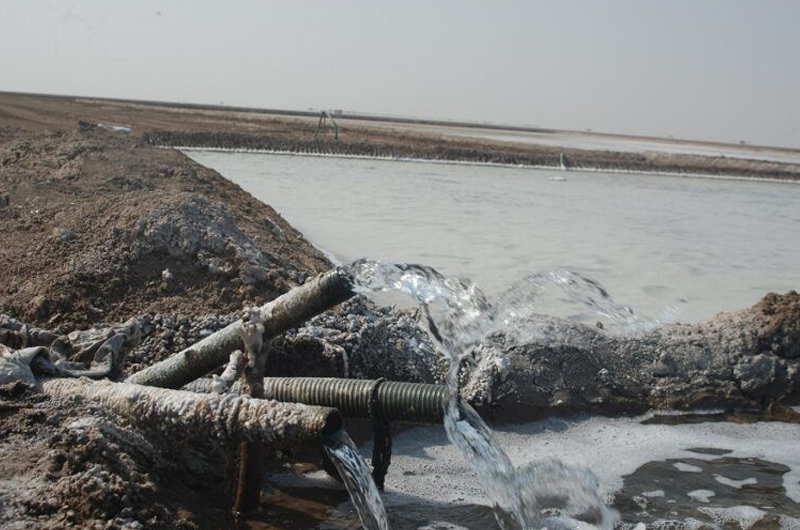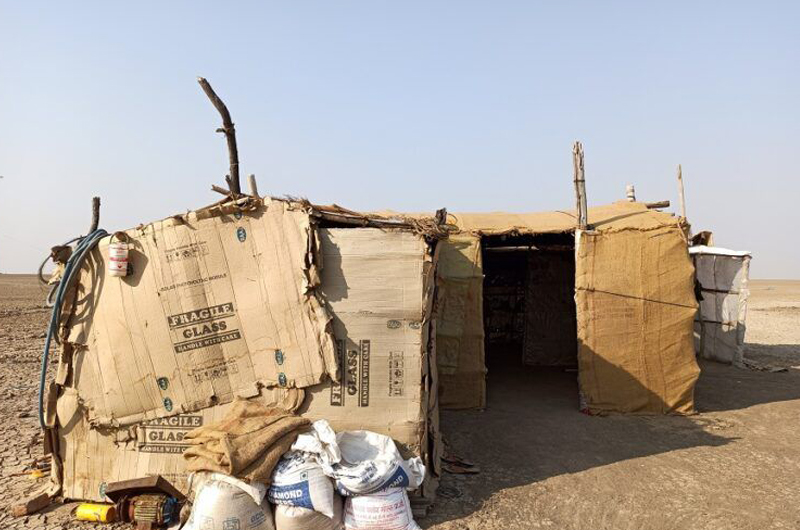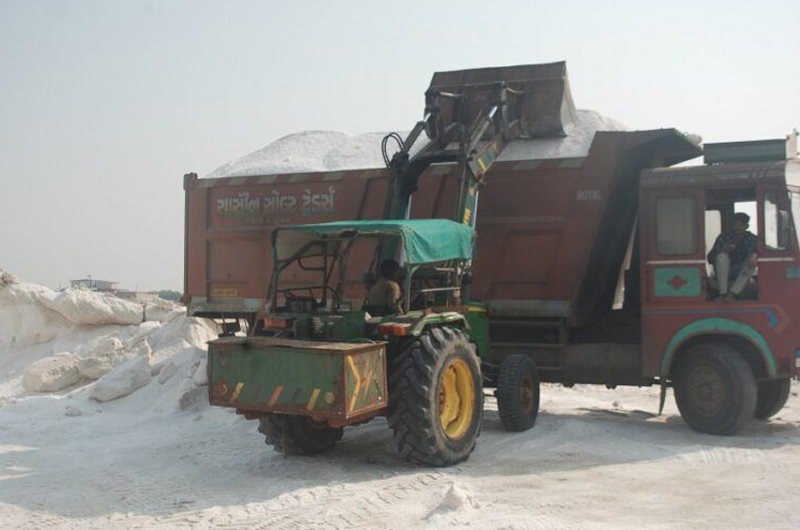The Forest Department of Gujarat has officially acknowledged the role of Agariyas, the salt workers of the Little Rann of Kutch, in wildlife conservation, particularly of the wild ass that is predominantly found in the region. Agariyas have traditionally been making salt from underground brine in the Little Rann of Kutch. In 1973, the area was designated as a Wild Ass Sanctuary and their access to it was restricted by the Forest Department. The latest acknowledgment gives the Agariyas official access to land and in turn, access to bank finance and markets. But legal recognition of their traditional rights, by rights settlement, is still awaited. Ravleen Kaur reports
Tejal Makwana is packing her bags for the annual sojourn to the salt desert. After the Dussehra festival, she and her husband Danabhai Makwana will rent a tractor, load it with a plastic water tank filled with drinking water for the next 20 days, solar panels, a pump, a diesel genset, tools to make salt, groceries and kitchen essentials. These supplies will keep them afloat for the next seven months she will spend in the Little Rann of Kutch (LRK), 10 km from their village Junagam in Gujarat’s Surendranagar District.
The first task would be to set up a chapra or a makeshift hut, with bamboo poles and jute sacks, which would be her home till summer assails this cracked landscape, bereft of trees. The floor of the chapra would be coated with dung of the Indian wild ass, found predominantly in this region. Then, the process of salt making will begin, by digging kui or temporary wells and creating two-feet embankments to make large pans or depressions in the desert. Once the floor of these pans is made impermeable by a series of manual processes, salty groundwater will be pumped from the kuis and spread there. Over the winter, this brine will be converted into salt.
This year (2023), Tejal Makwana must carry an identity card issued to her by the Gujarat Forest Department to confirm she is an Agariya, a community of salt workers, who have recently been given official access to LRK, after years of restrictions, to continue practicing their traditional profession of salt farming. In 1973, around 5,000 square kilometres of LRK was notified as a Wild Ass Sanctuary (WAS), one of the last refuges of the Indian wild ass, which is only found in the Kutch Region of Gujarat. Since then, the presence of Agariyas was considered a threat to the wildlife protection efforts in LRK, by wildlife conservationists and the forest department. This resulted in eviction notices, no access to welfare schemes and no livelihood insurance in case of natural disasters such as flooding.
However, recent reports by the state Forest Department to the National Green Tribunal (NGT) and Gujarat High Court, have recognised that Agariyas have in fact contributed to the conservation of wild ass in the region. “Population estimates of wild ass show that though there is manifold increase in the number and area of salt pans, wild ass population improved from meagre 362 in 1969 to 4451 in 2014 and 6082 in 2020. This shows that salt production activities have no negative impact on wildlife,” said an affidavit filed by the forest department in the high court this July. “…peaceful co-existence of Agariyas and Wild Ass resulted into the continuous growth of population of Wild Ass in the Wild Ass Sanctuary Area,” said another report filed by a joint committee constituted by the NGT in response to an order by the Tribunal in February this year. The joint committee report was filed in response to a suo moto cognisance by the NGT in January of a media report citing illegal encroachments in WAS.
Both the NGT case and the PIL in the Gujarat High Court were on the matter of illegal encroachment and ‘salt mining’ damaging the ecology and wildlife in WAS, including lesser flamingoes, desert foxes, wolves, and caracals besides the wild ass. In their affidavit in response to the PIL, the Forest Department also stated that as per the Mines Act, 1952, salt production is not a mining activity.

The history and geography of LRK
LRK is a low-lying bowl-shaped tract of land. During monsoon, 11 big and small rivers drain into LRK while water from the Arabian Sea also enters from a conical creek at another end, making it a large wetland from July to October. While fishers earn a living from the LRK in monsoon, once the water drains off, Agariyas enter the region that has huge reserves of underground brine, hard topsoil, a lot of sunlight, and very low humidity, making it ideal for salt production. Gujarat produces 76 per cent of India’s salt.
As per historical records, salt was being produced in LRK from the Mughal period. “When the British controlled salt operations before 1947, there were more facilities in the Rann than now,” said B.D. Baithani, a scholar on salt works in the LRK. “They constructed a railway track from the Kharagoda Railway Station to the Rann. Thirty-six wagons plied on this track to load salt directly from the pans. There was a water pipeline that provided drinking water to overhead tanks inside the Rann, unlike now when people have to fetch it from outside or depend on water tankers that the government sends once a week,” said Baithani, who hails from an Agariya family and stays in Patdi Block of Surendranagar. Kharagoda Railway Station, right at the edge of LRK, is one of the oldest railway stations in the country that the British administration set up to transport salt to various parts of the country, informed Baithani. “The track and other concrete structures in LRK were dismantled in 1973 when the Rann was declared a sanctuary,” he said.
Post India’s independence, individual Agariyas, who had become salt labourers under the British regime, were allowed to make salt in the Rann, says a paper, Yet to be Freed by Sandharbh Studies, Ahmedabad, on the condition of Agariyas. The paper, for the National Consultation on Salt Workers, India, says that no permissions and licenses were required by Agariyas, who made salt in 10-acre patches of land as they were considered small producers. They were not charged any cess either. This was because India was still heavily dependent on imports despite many natural sources for salt making and known traditional technologies to produce salt.
The season begins
The salt season begins from Dussehra every year, depending on whether the Rann has dried up. The 60,000-odd Agariyas at the Little Rann produce 30 per cent of India’s inland salt. Following the reports in the NGT case and the PIL, around 5,000 Agariyas, traditionally practising salt farming, can now have legitimate access to land, bank finance and market access and can even ask for a minimum support price for their produce, said Harinesh Pandya, trustee of the Agariya Heetrakhshak Manch (AHRM), a non-profit working for the rights of Agariyas.
“For the first time, the Forest Department has taken a radical stand and officially recognised the role of the Agariya Community in wildlife conservation. The report also affirms that there is no ‘mining’ of salt and that it is a traditional occupation that has been practised for centuries. This is the turning point in the 50 years long process of survey and settlement (of WAS),” said Pandya. But while the latest acknowledgements of their role in wildlife conservation has certainly eased access, the Agariyas still don’t have legal rights over the land on which they have been making salt for centuries.
On September 4 (last year), Agariya representatives, met the state Environment Minister Mulu Bera and were promised that their rights to make salt in LRK will be formally recognised. However, no official order has been issued yet. Hingor Rabari, president of the Kharagoda Iodized Salt Manufacturers’ Association, called the September 4 promise by the environment minister an election stunt. “The Agariya community is a big vote bank. If they (government) really wanted to do something, they would have completed the S&S by now and given the rights officially. This time, because the Agariyas united and complained, the government has softened,” he said.
As per law, a sanctuary can only be ‘declared’ once the Survey and Settlement (S&S) of the rights of people dependent on it has been completed. An incomplete S&S, over the last 50 years, is delaying the declaration of the sanctuary, says Pandya. There are many Agariyas whose names do not figure in the ongoing S&S process but have been farming salt for generations. “Almost 90 per cent of Agariyas don’t have their names there. Many have even died. When the survey was conducted in 1997, many Agariyas had already migrated to the Rann and were not available at their village address,” said Gunawant Koli, an Agariya in Kuda salt works in Dhrangadra Block. Only 3,000 Agariyas are listed in the provisional S&S list, while more than 10,000 are operating in LRK as of now, said Pandya.

Conditional access
“We have issued interim orders to recognise the rights of Agariyas, whose name figures in the provisional S&S report. The baseline year for that is 2004-05. Only those Agariyas who were producing salt then and with the same machines and technology used then will be allowed to enter the Rann and produce salt now,” Dhaval Gadhvi, deputy conservator of forests, WAS, told Mongabay India.
The forest department is issuing ‘Agar’ cards to such Agariyas, said Gadhvi. However, instead of respite, these cards have caused panic. “The card is only valid for a year and lists 23 conditions, most of which are impractical if one has to cultivate salt,” said Bachchu Bhai Degama, leader of the Agariya Mahasangh, a newly formed front by the Agariyas to voice their grievances. “For instance, they have restricted the number of wells to extract brine to only two. Brine is not equally distributed under the Rann. And with the water level going down, we sometimes have to dig 10-15 kuis before finding it. How will we manage with just two? Then, they (Forest Department) has restricted carrying inflammable substances inside the Rann. Solar can be used only during the day. We use crude oil at night to power the pump to extract brine. It is not possible to manage without crude,” said Degama, an Agariya from Degam village in Patdi. “All we want is an identity card that says we are Agariyas, not a card full of conditions. We have approached our MLA with this complaint and he has assured help,” said Degama.
The conditions also pose a challenge for traders, who enter the scene when the salt is ready. “They have disallowed the use of heavy machinery. JCB loaders are used to lift salt, trucks to transfer it and even equipment needed to dig borewells falls under heavy machinery. It is difficult to find so much labour nowadays to do these jobs,” Hingor Rabari, told Mongabay India. According to DCF Gadhvi, removing heavy machinery from WAS is their main objective. “A JCB is just for comfort, not a necessity,” he said. Ambu Patel said that mechanisation should be allowed for individual Agariyas but not at the industry level as high groundwater extraction is already depleting the limited brine reserves in LRK.

The restriction on the use of heavy machinery impacted the salt collection when it was ready to be lifted in March-April this year, the forest department officials stepped in and disallowed the use of heavy machinery. “Why are we making the salt if it can’t be lifted? First, they didn’t allow it, and then it rained, soaking the salt and leading to wastage. We appealed to the MLA of Patadi-Dasada, Parshottam Parmar, from the ruling party in the state. By the time, the permission came, it was already 15-20 days late. Only we know how difficult it is to stay in the scorching sun here in that season, with rationed food and water supplies,” said Makwana.
According to Pandya, LRK produces a maximum quantity of handmade salt in India, but there must be a balance between its fragile ecology and the livelihoods there. “This ecosystem can only sustain a limited number of people. Only those Agariyas practicing salt making since generations should be allowed, not big industries or those who take salt pans on lease,” he said.
(Courtesy: Mongabay-India/ india.mongabay.com)



 from Webdoux
from Webdoux